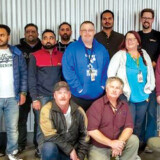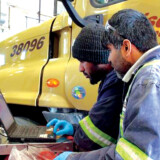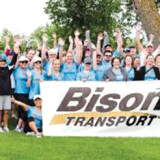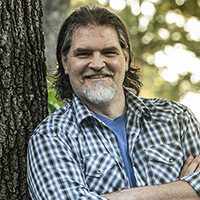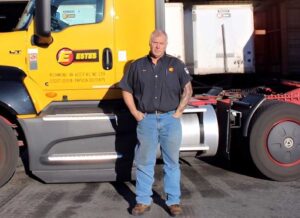Over the decades Garth Pitzel has been in the trucking business, he’s seen a lot of things come and go. For instance, he can remember when his employer, industry giant Bison, could fit all its drivers under one roof.
Times have certainly changed for the 2,300-driver Canadian carrier — and that includes its approach to safety. In fact, it’s hard to find a better example of a safety-first culture than Bison’s consistent multi-faceted approach.
But, as Pitzel shared with Truckload Authority, the company’s reputation as one of trucking’s safest carriers — with a trophy case stuffed with accolades to match — has been a long time coming.
“If you look at where we were — we focused on compliance and that doesn’t make you safe,” said Pitzel, Bison’s associate vice president of safety and driver development. “We proved that every day; we weren’t safe in the ’90s. So, we shifted from just being compliant to becoming both a safe and compliant company.
“When we started on this, we wanted to design the best safety toolbox a professional driver could have,” he continued. “Give them the best safety equipment, give them the best training and skills development, and give them the best policy to support safe driving. None of this happens without people. That’s the most important part. You have to value people first.”
Of the steps Bison has taken to make safety a mindset for every employee, the most impressive could be Bison’s right-to-decide policy. This company guideline puts accountability into the hands of the driver in a manner that’s largely unheard of in the industry.
“Our right-to-decide policy gives the authority and responsibility to the person performing the task to discontinue that task if it’s unsafe to do it,” Pitzel said. “So, for a driver, that means to decide when not to drive due to the condition of the equipment, condition of the roadways, weather, and most importantly, the condition of the driver.
“When you look at that overall safety toolbox we provide, and you look at this right to decide, it leaves no doubt that our people are the most important thing,” he added. “Safety is a partnership; from a company perspective, it’s our responsibility to make sure each driver has the necessary skills to make it home safely from each and every trip. The driver’s responsibility is to use those skills every mile they run for us so that they make it home safely.”
Another element of the company’s safety processes and protocols is a corps of safety counselors, which exists to provide coaching to drivers and help ascertain when additional training is needed. While this program has been around for quite some time, Pitzel said, it wasn’t overly effective — until the company changed its approach from enforcement and punishment to being a helpful, supportive resource for drivers.
“(The safety counselors’) job is to do one of two things — to hold conversations to determine if that driver just needs a coaching event or if they need further training,” Pitzel said, adding that for counseling to be effective, it can’t always be negative.
“A driver doesn’t get up in the morning and say they’re going to have a bad day or have an accident,” he said. “When they have an issue, you’ve got to get down to the root cause. Once they correct it, it’s just as important to communicate with them and thank them for their efforts, rather than to just beat them with a stick. You’ve got to have some positive reinforcement.”
Another aspect of Bison’s overall safety program that’s paying off is the systematic manner in which behaviors are addressed to improve performance. Pitzel cited a recent example in which the company sought to cut down incidents involving adverse weather conditions, leveraging drivers to be on the front line of improvement.
“Our results were not good two winters ago. We identified a combination of factors that contributed to every accident — light load, high winds, and over-driving the conditions,” he said. “We stressed that, and we challenged our drivers to help be part of the solution. The result was 46% fewer accidents last winter than the year before. Our drivers absolutely responded, and I got out and thanked them for it.”
Pitzel is quick to point out that the new approach doesn’t come at the expense of the drivers’ accountability and adherence to rules. But he’s equally emphatic about the company’s ability to see different ways to deliver messages and drive for collaborative improvement in a manner employees hear and understand.
“This whole thing is like a puzzle, and the puzzle is cut in a different way for every driver. Our job as a company is to put it together,” he said. “We strive toward continual improvement.
“Our major accidents, since 2020, have reduced by 27%,” he continued. “We have a safe driving award program that’s paid out $50 million to our drivers since 2005. Last year, January to October, we did almost 3,900 classroom courses and just under 12,000 online courses for our drivers. And for the first nine months of last year, we had 14,092 coaching conversations through our safety counselors — 3,752 being proactive conversations, not reactive.”
All the time, money, and expertise that represents is a small price to pay for bringing everyone home to their loved ones safely, which is the constant, overriding goal, according to Pitzel.
“I do a quarterly board report, and the first question I have to answer is, ‘Did everybody make it home? Yes or no?’ That’s what drives safety as part of the culture we have here,” he said. “The worst thing I have to do is phone somebody’s family and say they aren’t coming home. That’s the only thing on my job description that I’d be happy to get away with not doing.”
This article originally appeared in the September/October 2023 edition of Truckload Authority, the official publication of the Truckload Carriers Association.
Dwain Hebda is a freelance journalist, author, editor and storyteller in Little Rock, Arkansas. In addition to The Trucker, his work appears in more than 35 publications across multiple states each year. Hebda’s writing has been awarded by the Society of Professional Journalists and a Finalist in Best Of Arkansas rankings by AY Magazine. He is president of Ya!Mule Wordsmiths, which provides editorial services to publications and companies.









